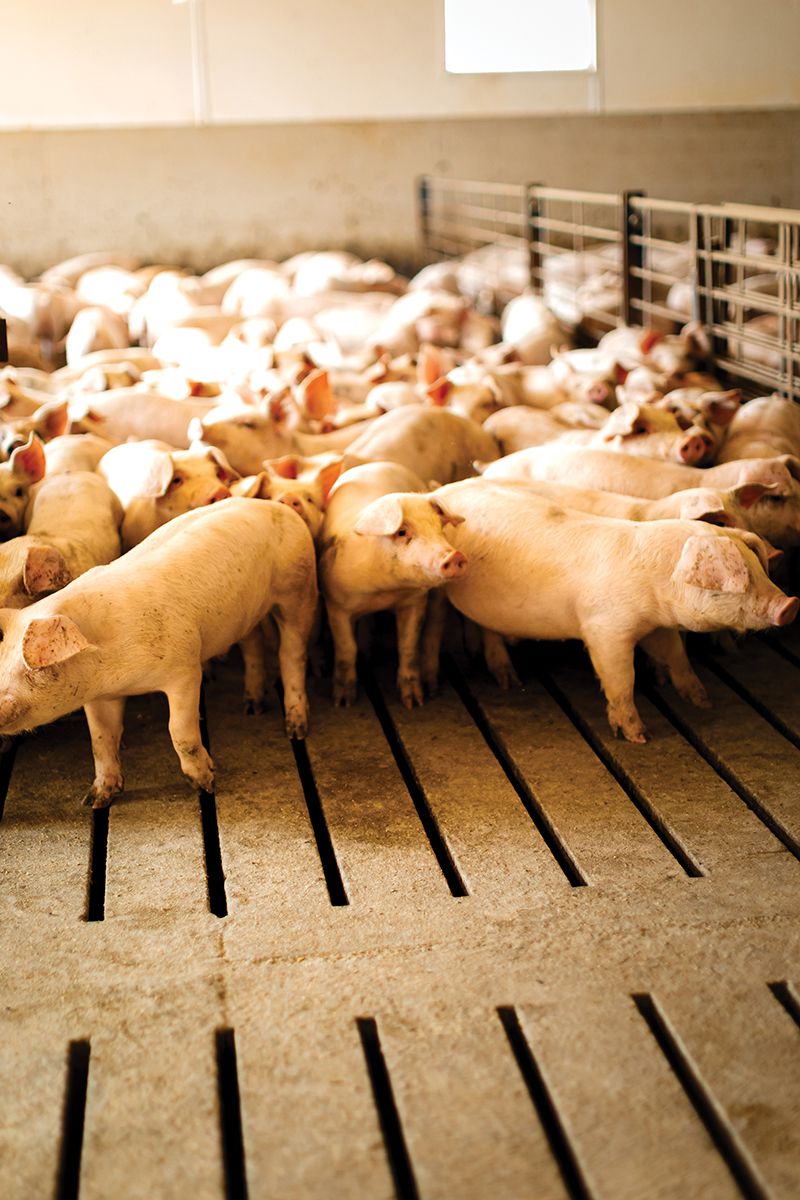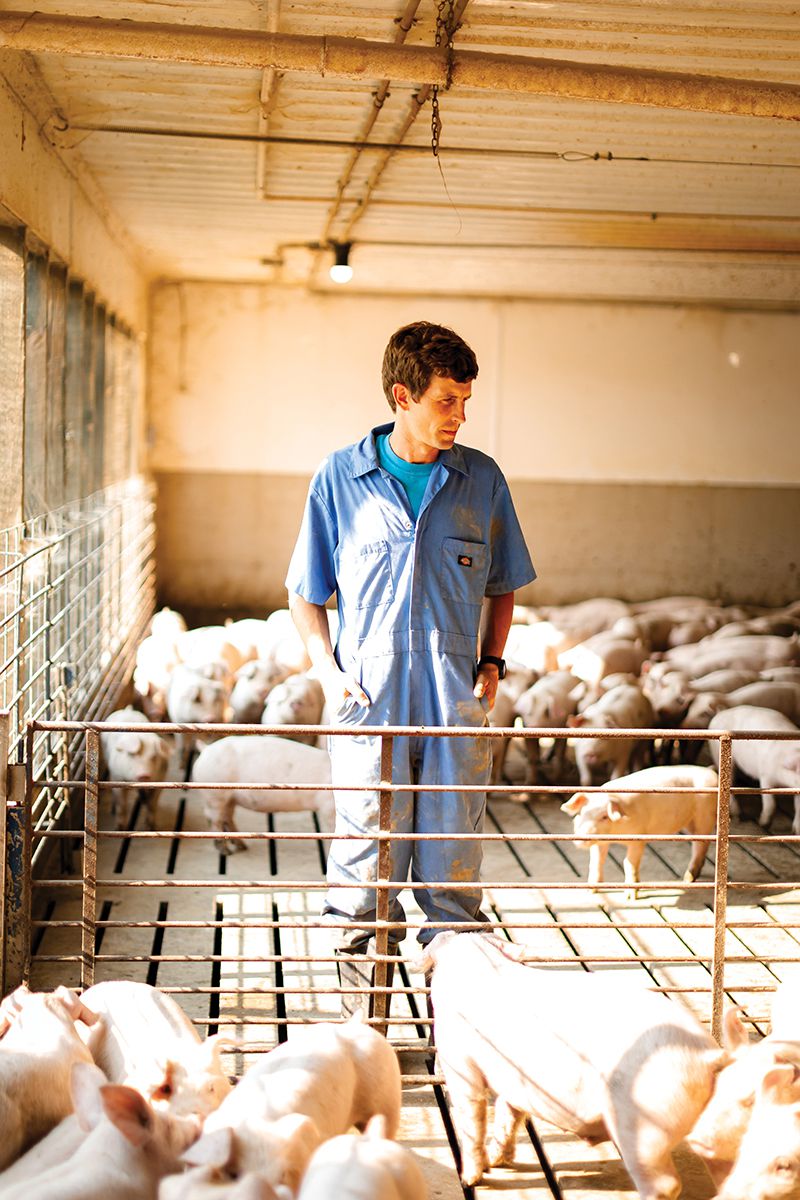Bringing Home the Bacon
Author
Published
3/27/2025
As owner-operators of an independent farrow-to-finish farm in Madelia, Minnesota, Dan and Megan Roberts’ operation is unique. “Independent farrow-to-finish is no longer very common,” explains Dan, a fourth-generation farmer. “Today, it’s very much segmented out. There are many owners of sow sites and grow-to-finish farms, and there are people who operate feed mills, but to do the whole process is no longer common. It’s much more specialized.”
For Dan, however, it’s second nature. Growing up, he spent every non-school day at the farm, helping his dad, uncle and grandpa raise pigs and grow corn and soybeans. Once Dan graduated from the University of Minnesota, Twin Cities, where he met his wife, Megan, they moved back to the farm in 2010. As Dan became more involved in the farm, eventually taking ownership, Megan earned her master’s degree in Science, Technology and Environmental Policy, and a doctorate in Agricultural Education. She now serves as the in-house ag economist for Compeer Financial, a $33 billion lending institution that supports agriculture and rural communities in Minnesota, Illinois and Wisconsin.
Today, Dan continues to operate the farm with the help of his dad, Steve. Every year, their 600 sows produce 14,000 pigs that they raise from birth to market. Nearly 100 years since Dan’s great-grandparents bought the farm in the 1930s, they have their process down to a science: Once a sow gives birth, after a gestation period of about 115 days, the baby piglets stay with their mom for three to four weeks, until they’re ready to be weaned. From there, the piglets move to a nursery barn, where they learn how to eat a diet of ground corn and soybean meal. Five months later, when the pigs weigh between 270 and 300 pounds each, they are ready for market.
“Thirty to 40 years ago, our type of operation would not have been uncommon,” Dan says, noting they also run a feed mill onsite and haul their own manure. “But the swine industry has evolved, like everything else.”
 The State of Swine
The State of Swine
With 3,000 pig farming families across the state, Minnesota is the second largest producer of pork in the country, behind Iowa. In 2023 alone, 16.73 million pigs from Minnesota were marketed, contributing to a total economic output of $12.53 billion, according to a report by the National Pork Producers Council (NPPC) called “The Minnesota Pork Industry 2023.” That same year, Minnesota was responsible for 849.18 million pounds of pork exported internationally, making up a portion of the 25% of U.S. pork production that is shipped abroad.
“Pork is the number one consumed protein in the world, and our farmers have a great story to share about the affordability, sustainability and quality of the products they raise that appeals to consumers domestically and internationally,” says Jill Resler, CEO of the Minnesota Pork Producers Association (MPPA) and the Minnesota Pork Board.
Though Minnesota is an exceptional place to raise pigs, says Resler—highlighting factors like progressive farmers who invest in cutting-edge technologies, fertile soils, access to veterinary medicine experts and strong agricultural infrastructure—pig farmers are currently facing significant challenges, namely disease management and labor shortages.
MPPA established a task force made up of industry leaders to address pig health challenges like Porcine Reproductive and Respiratory Syndrome, one of the most persistent threats.
To address labor shortages, the MPPA is working with industry stakeholders, congressional offices and the NPPC to advocate for the continued utilization of TN visas, which allow qualified Canadian and Mexican citizens to seek temporary entry into the U.S. to engage in business activities.
Even as the number of pig farms in Minnesota has decreased in recent decades—from 7,765 in 1997 to 2,928 in 2022—the average inventory of pigs per farm has increased from roughly 730 to 3,031 in the same time span. And, despite the consolidation, 100% of Minnesota pig farms continue to be family-owned.
In the years to come, Resler says, “The most significant measure of success will be ensuring that generational family farms, some of which have operated in Minnesota for as many as seven generations, continue to thrive and lead the U.S. pork industry.”
Implementing sustainable practices is one way to ensure the longevity of the pork production industry. “Minnesota pig farmers believe sustainability must be holistic, including social, economic and environmental sustainability,” Resler says. “We believe that sustainability is fundamentally about supporting farmers’ freedom to operate and ensuring that they can continue to raise pigs in a way that is responsible, profitable and environmentally sound.”
To encourage sustainability across the industry, one of the key initiatives of the Minnesota Pork Board—the checkoff-funded organization representing Minnesota pig farmers in the areas of promotion, research and education—is its engagement in the Climate-Smart Commodities: Advancing U.S. Pork Grant, a USDA-backed project designed to help farmers adopt and measure on-farm practices. Through this initiative, the Minnesota Pork Board is supporting pig farmers in completing on-farm sustainability reports, which provide valuable insights into their current practices and identify opportunities for improvement.
Sustainable Practices for Long-Term Viability 
For the Roberts family, integrating sustainable practices is an important piece of safeguarding the future of the farm should their son, Evan, eventually want to take over. “My focus is on making sure that we are investing our time and energy into things that provide a long-term, sustainable return,” Dan says. “That’s how I approach anything. Does this decision help us preserve and grow in a common sense, disciplined manner?”
One recent upgrade, for example, is an automated feed milling system that ensures every pig gets a precise amount of feed. This system enables Dan to track improvements in feed efficiency and average daily gain in their market hog production. The Roberts have also made two separate investments in solar energy installations in their grow-to-finish sites.
“As long as we’re making investments that have long-term viability, then we can sort of let go of the preconceived notions of ‘this is exactly what the farm is going to look like,’ because we don’t know that for certain,” Megan says. “Our long-term goal is to keep going. When it involves hogs, there are some really significant unknowns, so we hope to continue to be a sustainable, efficient, profitable hog operation that’s taking good care of our pigs, our employees and our environment. But there could be something that would prevent us from doing that. There could be a disease issue. There could be market issues. So, when we talk about goals, we just want to keep doing this.”
Their efforts recently earned them the American Farm Bureau Federation Young Farmers & Ranchers (YF&R) Achievement Award. They were the first competitors from Minnesota to win the national competition, in which contestants are evaluated on a combination of their farming operation growth and financial progress, as well as leadership within and outside of Farm Bureau. Dan serves as the president for the Blue Earth County Farm Bureau, while Megan has previously participated in the YF&R Discussion Meet, winning the state competition in 2017 to advance to the national competition.
“They are really interested in getting to know your story, your family, who you are,” Megan says of the YF&R Achievement Award judges. “Something they shared with us afterward was that they really felt like they got an idea of who we are and what our family commitment is—both to our farm but also other aspects. We’re hopefully not one-dimensional and just thinking about our farm. We really try to think about: How does this impact our family? How does this impact our community?”
By the Numbers: Minnesota Pork Production
3,031
Average number of pigs per farm in 2022, over four times the average in 1997
9.3 million
Pig population in Minnesota as of 2023
181,285
Tons of soil pig farmers saved in 2022—the equivalent of 11,330 dump truck loads
100%
Percentage of pig farms in Minnesota that are family-owned
142.75 million
Bushels of corn Minnesota pigs consume annually
849.18 million
Pounds of Minnesota pork exported internationally in 2023
$12.53 billion
Total economic output of Minnesota’s pork industry in 2023